Impact of Light Rail Transit on Urban Development
VerifiedAdded on 2020/04/07
|13
|3365
|212
AI Summary
This assignment delves into the multifaceted impacts of light rail transit (LRT) on urban environments. It examines how LRT influences land use patterns, property values, pedestrian activity, air quality, and public health. Drawing upon various academic sources, the analysis sheds light on the economic benefits of LRT-driven development, its role in revitalizing urban areas, and the potential challenges associated with its implementation.
Contribute Materials
Your contribution can guide someone’s learning journey. Share your
documents today.
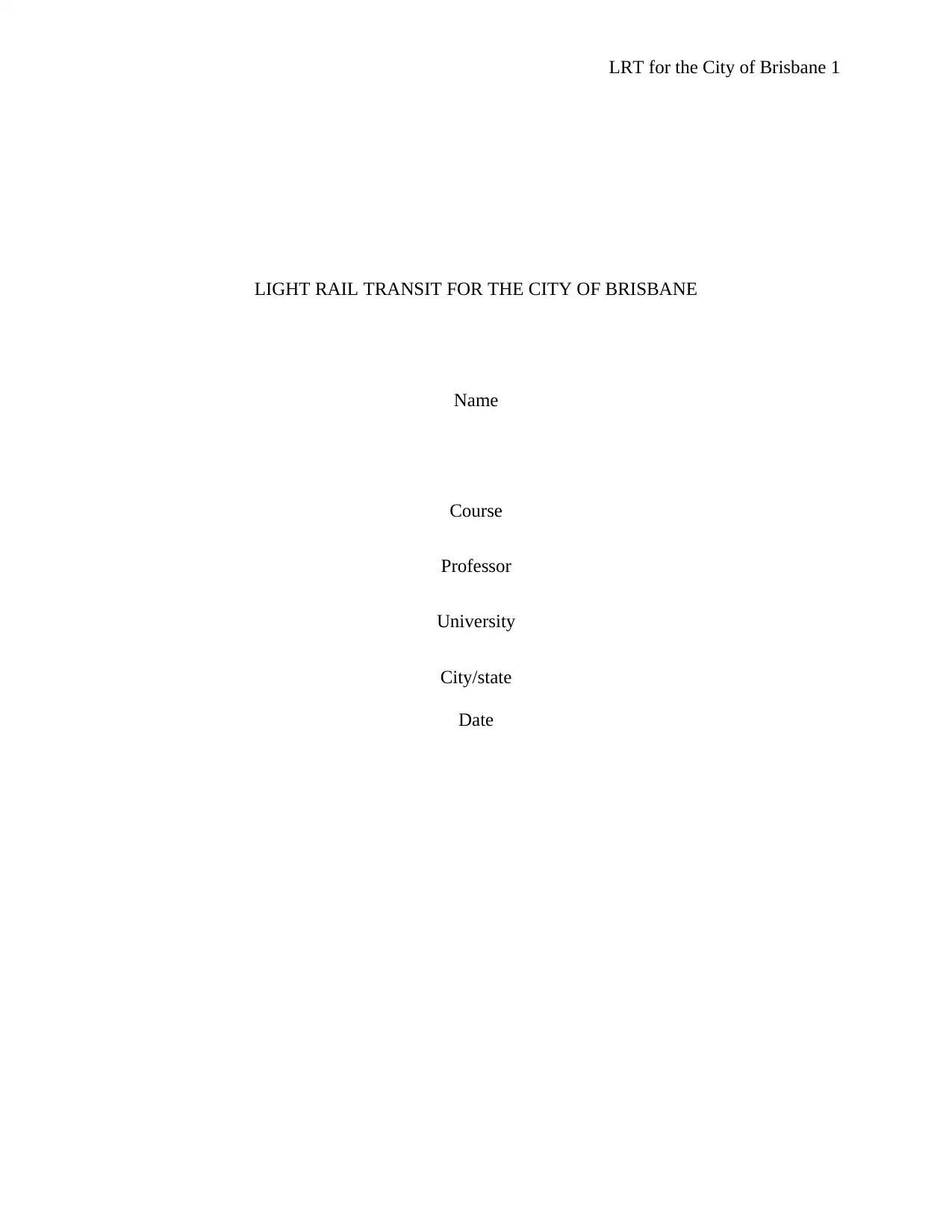
LRT for the City of Brisbane 1
LIGHT RAIL TRANSIT FOR THE CITY OF BRISBANE
Name
Course
Professor
University
City/state
Date
LIGHT RAIL TRANSIT FOR THE CITY OF BRISBANE
Name
Course
Professor
University
City/state
Date
Secure Best Marks with AI Grader
Need help grading? Try our AI Grader for instant feedback on your assignments.
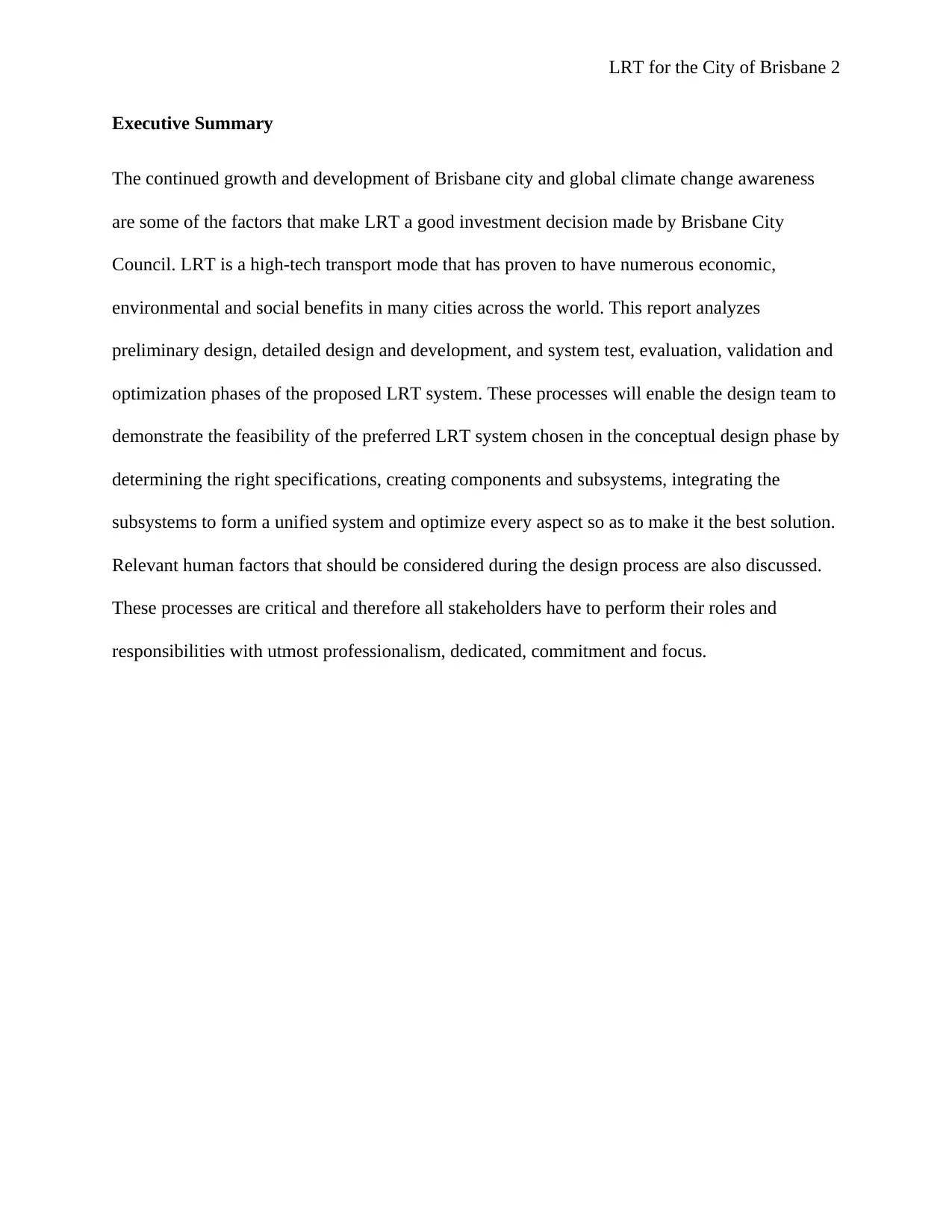
LRT for the City of Brisbane 2
Executive Summary
The continued growth and development of Brisbane city and global climate change awareness
are some of the factors that make LRT a good investment decision made by Brisbane City
Council. LRT is a high-tech transport mode that has proven to have numerous economic,
environmental and social benefits in many cities across the world. This report analyzes
preliminary design, detailed design and development, and system test, evaluation, validation and
optimization phases of the proposed LRT system. These processes will enable the design team to
demonstrate the feasibility of the preferred LRT system chosen in the conceptual design phase by
determining the right specifications, creating components and subsystems, integrating the
subsystems to form a unified system and optimize every aspect so as to make it the best solution.
Relevant human factors that should be considered during the design process are also discussed.
These processes are critical and therefore all stakeholders have to perform their roles and
responsibilities with utmost professionalism, dedicated, commitment and focus.
Executive Summary
The continued growth and development of Brisbane city and global climate change awareness
are some of the factors that make LRT a good investment decision made by Brisbane City
Council. LRT is a high-tech transport mode that has proven to have numerous economic,
environmental and social benefits in many cities across the world. This report analyzes
preliminary design, detailed design and development, and system test, evaluation, validation and
optimization phases of the proposed LRT system. These processes will enable the design team to
demonstrate the feasibility of the preferred LRT system chosen in the conceptual design phase by
determining the right specifications, creating components and subsystems, integrating the
subsystems to form a unified system and optimize every aspect so as to make it the best solution.
Relevant human factors that should be considered during the design process are also discussed.
These processes are critical and therefore all stakeholders have to perform their roles and
responsibilities with utmost professionalism, dedicated, commitment and focus.
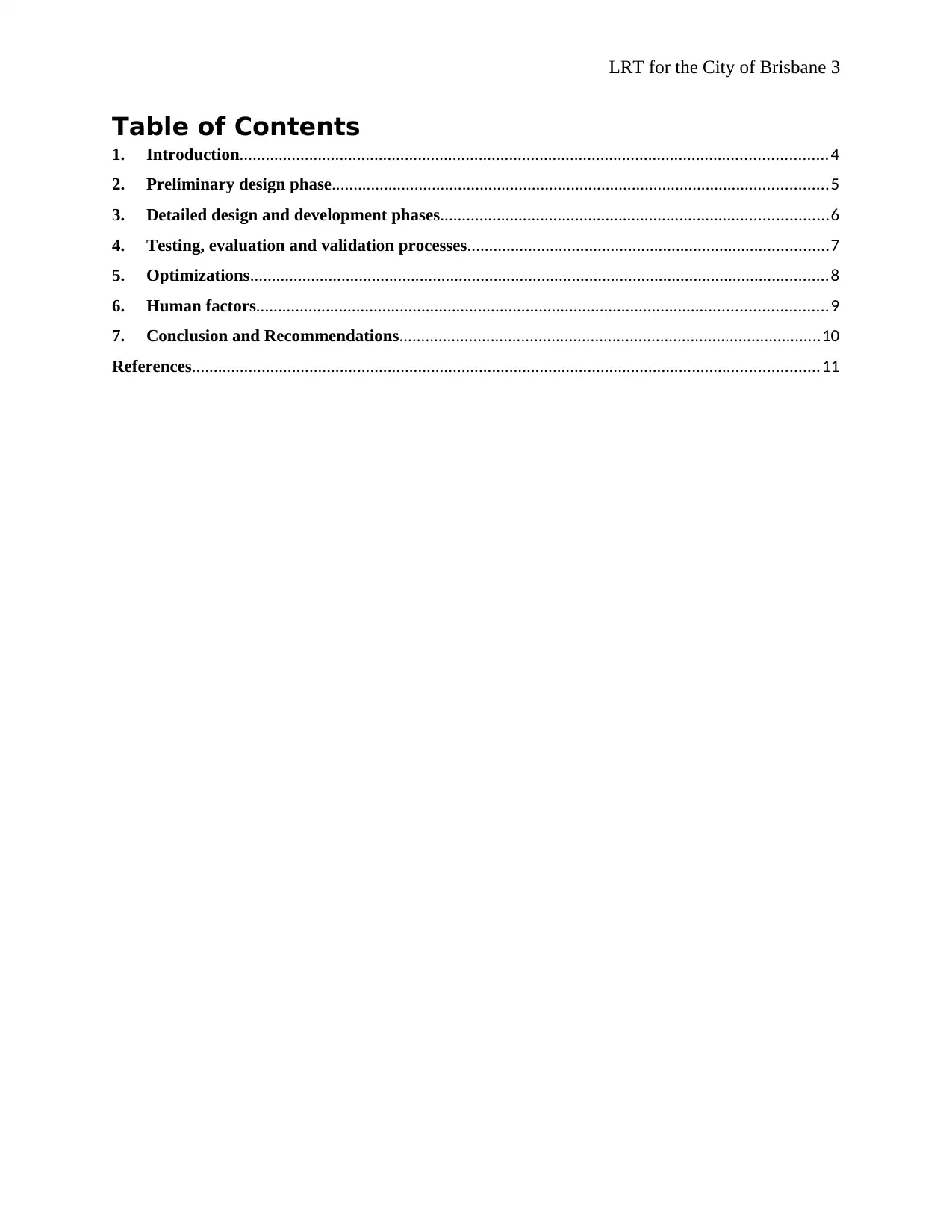
LRT for the City of Brisbane 3
Table of Contents
1. Introduction.......................................................................................................................................4
2. Preliminary design phase..................................................................................................................5
3. Detailed design and development phases.........................................................................................6
4. Testing, evaluation and validation processes...................................................................................7
5. Optimizations.....................................................................................................................................8
6. Human factors...................................................................................................................................9
7. Conclusion and Recommendations.................................................................................................10
References................................................................................................................................................11
Table of Contents
1. Introduction.......................................................................................................................................4
2. Preliminary design phase..................................................................................................................5
3. Detailed design and development phases.........................................................................................6
4. Testing, evaluation and validation processes...................................................................................7
5. Optimizations.....................................................................................................................................8
6. Human factors...................................................................................................................................9
7. Conclusion and Recommendations.................................................................................................10
References................................................................................................................................................11
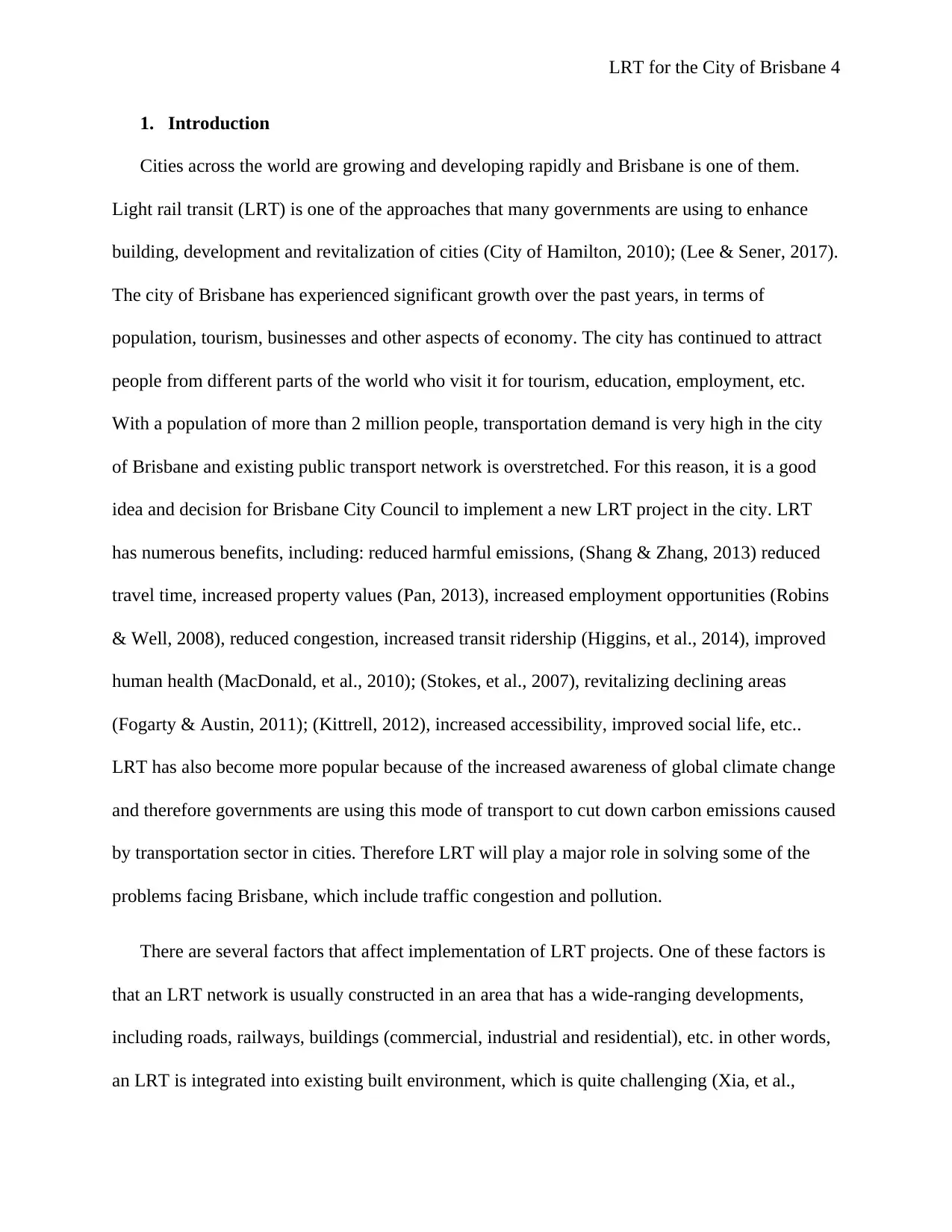
LRT for the City of Brisbane 4
1. Introduction
Cities across the world are growing and developing rapidly and Brisbane is one of them.
Light rail transit (LRT) is one of the approaches that many governments are using to enhance
building, development and revitalization of cities (City of Hamilton, 2010); (Lee & Sener, 2017).
The city of Brisbane has experienced significant growth over the past years, in terms of
population, tourism, businesses and other aspects of economy. The city has continued to attract
people from different parts of the world who visit it for tourism, education, employment, etc.
With a population of more than 2 million people, transportation demand is very high in the city
of Brisbane and existing public transport network is overstretched. For this reason, it is a good
idea and decision for Brisbane City Council to implement a new LRT project in the city. LRT
has numerous benefits, including: reduced harmful emissions, (Shang & Zhang, 2013) reduced
travel time, increased property values (Pan, 2013), increased employment opportunities (Robins
& Well, 2008), reduced congestion, increased transit ridership (Higgins, et al., 2014), improved
human health (MacDonald, et al., 2010); (Stokes, et al., 2007), revitalizing declining areas
(Fogarty & Austin, 2011); (Kittrell, 2012), increased accessibility, improved social life, etc..
LRT has also become more popular because of the increased awareness of global climate change
and therefore governments are using this mode of transport to cut down carbon emissions caused
by transportation sector in cities. Therefore LRT will play a major role in solving some of the
problems facing Brisbane, which include traffic congestion and pollution.
There are several factors that affect implementation of LRT projects. One of these factors is
that an LRT network is usually constructed in an area that has a wide-ranging developments,
including roads, railways, buildings (commercial, industrial and residential), etc. in other words,
an LRT is integrated into existing built environment, which is quite challenging (Xia, et al.,
1. Introduction
Cities across the world are growing and developing rapidly and Brisbane is one of them.
Light rail transit (LRT) is one of the approaches that many governments are using to enhance
building, development and revitalization of cities (City of Hamilton, 2010); (Lee & Sener, 2017).
The city of Brisbane has experienced significant growth over the past years, in terms of
population, tourism, businesses and other aspects of economy. The city has continued to attract
people from different parts of the world who visit it for tourism, education, employment, etc.
With a population of more than 2 million people, transportation demand is very high in the city
of Brisbane and existing public transport network is overstretched. For this reason, it is a good
idea and decision for Brisbane City Council to implement a new LRT project in the city. LRT
has numerous benefits, including: reduced harmful emissions, (Shang & Zhang, 2013) reduced
travel time, increased property values (Pan, 2013), increased employment opportunities (Robins
& Well, 2008), reduced congestion, increased transit ridership (Higgins, et al., 2014), improved
human health (MacDonald, et al., 2010); (Stokes, et al., 2007), revitalizing declining areas
(Fogarty & Austin, 2011); (Kittrell, 2012), increased accessibility, improved social life, etc..
LRT has also become more popular because of the increased awareness of global climate change
and therefore governments are using this mode of transport to cut down carbon emissions caused
by transportation sector in cities. Therefore LRT will play a major role in solving some of the
problems facing Brisbane, which include traffic congestion and pollution.
There are several factors that affect implementation of LRT projects. One of these factors is
that an LRT network is usually constructed in an area that has a wide-ranging developments,
including roads, railways, buildings (commercial, industrial and residential), etc. in other words,
an LRT is integrated into existing built environment, which is quite challenging (Xia, et al.,
Secure Best Marks with AI Grader
Need help grading? Try our AI Grader for instant feedback on your assignments.
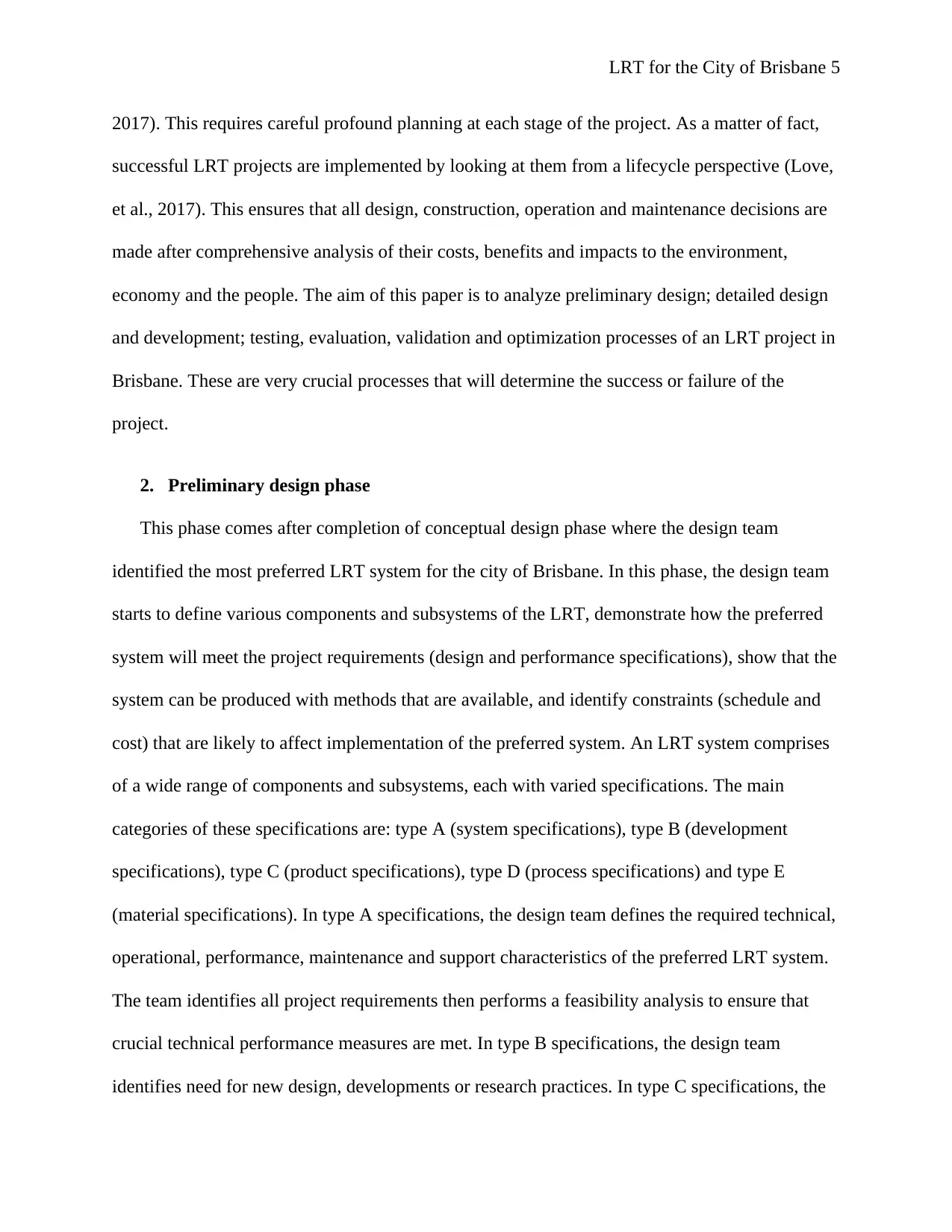
LRT for the City of Brisbane 5
2017). This requires careful profound planning at each stage of the project. As a matter of fact,
successful LRT projects are implemented by looking at them from a lifecycle perspective (Love,
et al., 2017). This ensures that all design, construction, operation and maintenance decisions are
made after comprehensive analysis of their costs, benefits and impacts to the environment,
economy and the people. The aim of this paper is to analyze preliminary design; detailed design
and development; testing, evaluation, validation and optimization processes of an LRT project in
Brisbane. These are very crucial processes that will determine the success or failure of the
project.
2. Preliminary design phase
This phase comes after completion of conceptual design phase where the design team
identified the most preferred LRT system for the city of Brisbane. In this phase, the design team
starts to define various components and subsystems of the LRT, demonstrate how the preferred
system will meet the project requirements (design and performance specifications), show that the
system can be produced with methods that are available, and identify constraints (schedule and
cost) that are likely to affect implementation of the preferred system. An LRT system comprises
of a wide range of components and subsystems, each with varied specifications. The main
categories of these specifications are: type A (system specifications), type B (development
specifications), type C (product specifications), type D (process specifications) and type E
(material specifications). In type A specifications, the design team defines the required technical,
operational, performance, maintenance and support characteristics of the preferred LRT system.
The team identifies all project requirements then performs a feasibility analysis to ensure that
crucial technical performance measures are met. In type B specifications, the design team
identifies need for new design, developments or research practices. In type C specifications, the
2017). This requires careful profound planning at each stage of the project. As a matter of fact,
successful LRT projects are implemented by looking at them from a lifecycle perspective (Love,
et al., 2017). This ensures that all design, construction, operation and maintenance decisions are
made after comprehensive analysis of their costs, benefits and impacts to the environment,
economy and the people. The aim of this paper is to analyze preliminary design; detailed design
and development; testing, evaluation, validation and optimization processes of an LRT project in
Brisbane. These are very crucial processes that will determine the success or failure of the
project.
2. Preliminary design phase
This phase comes after completion of conceptual design phase where the design team
identified the most preferred LRT system for the city of Brisbane. In this phase, the design team
starts to define various components and subsystems of the LRT, demonstrate how the preferred
system will meet the project requirements (design and performance specifications), show that the
system can be produced with methods that are available, and identify constraints (schedule and
cost) that are likely to affect implementation of the preferred system. An LRT system comprises
of a wide range of components and subsystems, each with varied specifications. The main
categories of these specifications are: type A (system specifications), type B (development
specifications), type C (product specifications), type D (process specifications) and type E
(material specifications). In type A specifications, the design team defines the required technical,
operational, performance, maintenance and support characteristics of the preferred LRT system.
The team identifies all project requirements then performs a feasibility analysis to ensure that
crucial technical performance measures are met. In type B specifications, the design team
identifies need for new design, developments or research practices. In type C specifications, the
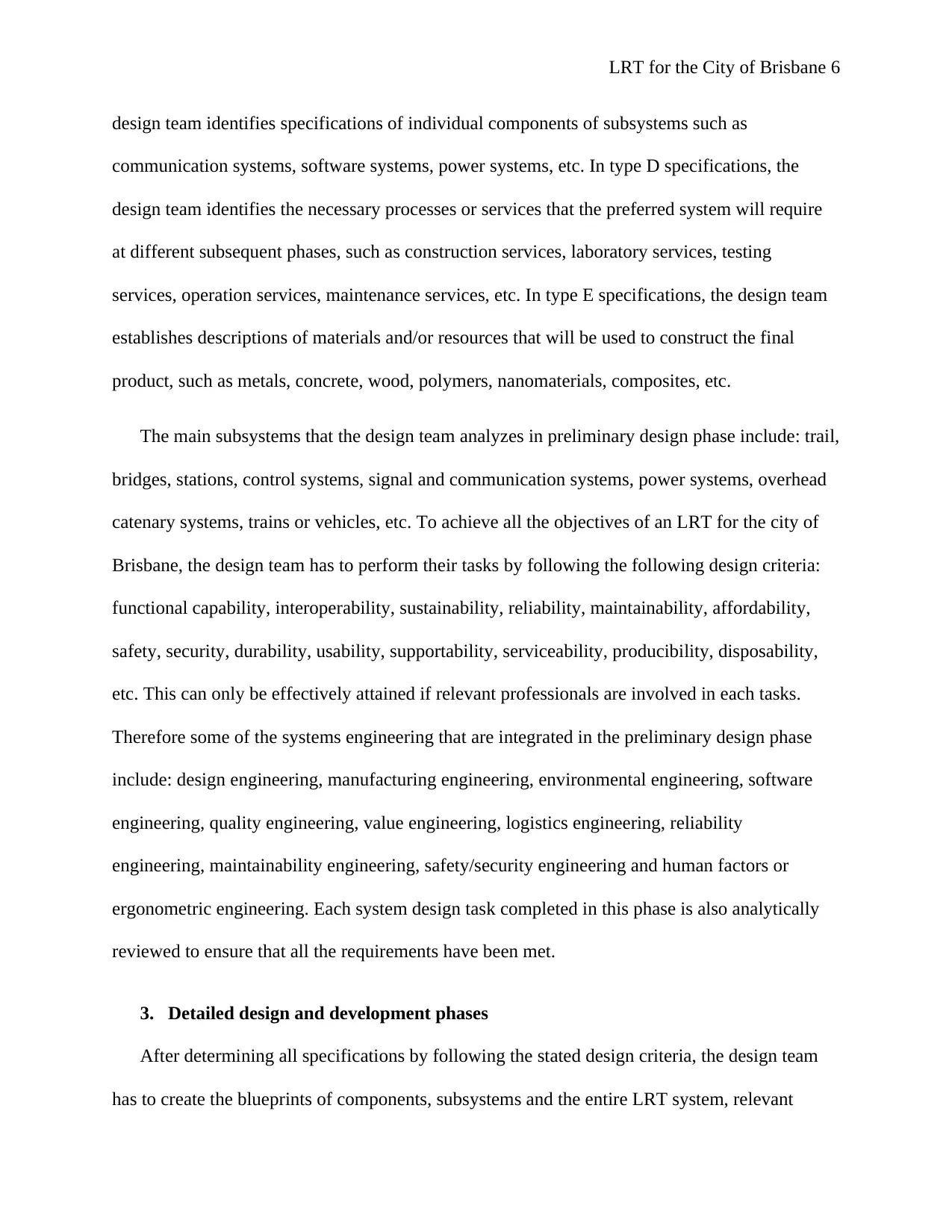
LRT for the City of Brisbane 6
design team identifies specifications of individual components of subsystems such as
communication systems, software systems, power systems, etc. In type D specifications, the
design team identifies the necessary processes or services that the preferred system will require
at different subsequent phases, such as construction services, laboratory services, testing
services, operation services, maintenance services, etc. In type E specifications, the design team
establishes descriptions of materials and/or resources that will be used to construct the final
product, such as metals, concrete, wood, polymers, nanomaterials, composites, etc.
The main subsystems that the design team analyzes in preliminary design phase include: trail,
bridges, stations, control systems, signal and communication systems, power systems, overhead
catenary systems, trains or vehicles, etc. To achieve all the objectives of an LRT for the city of
Brisbane, the design team has to perform their tasks by following the following design criteria:
functional capability, interoperability, sustainability, reliability, maintainability, affordability,
safety, security, durability, usability, supportability, serviceability, producibility, disposability,
etc. This can only be effectively attained if relevant professionals are involved in each tasks.
Therefore some of the systems engineering that are integrated in the preliminary design phase
include: design engineering, manufacturing engineering, environmental engineering, software
engineering, quality engineering, value engineering, logistics engineering, reliability
engineering, maintainability engineering, safety/security engineering and human factors or
ergonometric engineering. Each system design task completed in this phase is also analytically
reviewed to ensure that all the requirements have been met.
3. Detailed design and development phases
After determining all specifications by following the stated design criteria, the design team
has to create the blueprints of components, subsystems and the entire LRT system, relevant
design team identifies specifications of individual components of subsystems such as
communication systems, software systems, power systems, etc. In type D specifications, the
design team identifies the necessary processes or services that the preferred system will require
at different subsequent phases, such as construction services, laboratory services, testing
services, operation services, maintenance services, etc. In type E specifications, the design team
establishes descriptions of materials and/or resources that will be used to construct the final
product, such as metals, concrete, wood, polymers, nanomaterials, composites, etc.
The main subsystems that the design team analyzes in preliminary design phase include: trail,
bridges, stations, control systems, signal and communication systems, power systems, overhead
catenary systems, trains or vehicles, etc. To achieve all the objectives of an LRT for the city of
Brisbane, the design team has to perform their tasks by following the following design criteria:
functional capability, interoperability, sustainability, reliability, maintainability, affordability,
safety, security, durability, usability, supportability, serviceability, producibility, disposability,
etc. This can only be effectively attained if relevant professionals are involved in each tasks.
Therefore some of the systems engineering that are integrated in the preliminary design phase
include: design engineering, manufacturing engineering, environmental engineering, software
engineering, quality engineering, value engineering, logistics engineering, reliability
engineering, maintainability engineering, safety/security engineering and human factors or
ergonometric engineering. Each system design task completed in this phase is also analytically
reviewed to ensure that all the requirements have been met.
3. Detailed design and development phases
After determining all specifications by following the stated design criteria, the design team
has to create the blueprints of components, subsystems and the entire LRT system, relevant
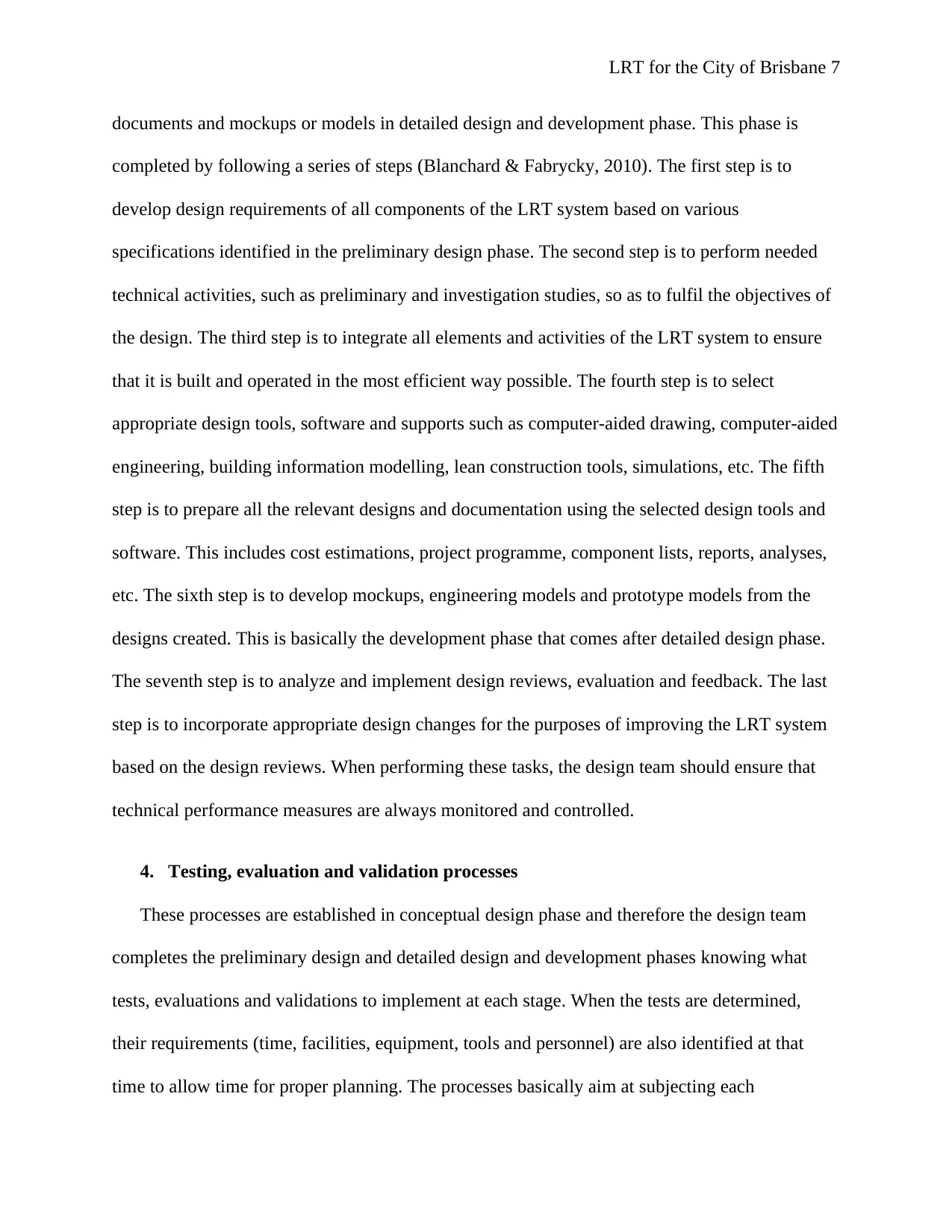
LRT for the City of Brisbane 7
documents and mockups or models in detailed design and development phase. This phase is
completed by following a series of steps (Blanchard & Fabrycky, 2010). The first step is to
develop design requirements of all components of the LRT system based on various
specifications identified in the preliminary design phase. The second step is to perform needed
technical activities, such as preliminary and investigation studies, so as to fulfil the objectives of
the design. The third step is to integrate all elements and activities of the LRT system to ensure
that it is built and operated in the most efficient way possible. The fourth step is to select
appropriate design tools, software and supports such as computer-aided drawing, computer-aided
engineering, building information modelling, lean construction tools, simulations, etc. The fifth
step is to prepare all the relevant designs and documentation using the selected design tools and
software. This includes cost estimations, project programme, component lists, reports, analyses,
etc. The sixth step is to develop mockups, engineering models and prototype models from the
designs created. This is basically the development phase that comes after detailed design phase.
The seventh step is to analyze and implement design reviews, evaluation and feedback. The last
step is to incorporate appropriate design changes for the purposes of improving the LRT system
based on the design reviews. When performing these tasks, the design team should ensure that
technical performance measures are always monitored and controlled.
4. Testing, evaluation and validation processes
These processes are established in conceptual design phase and therefore the design team
completes the preliminary design and detailed design and development phases knowing what
tests, evaluations and validations to implement at each stage. When the tests are determined,
their requirements (time, facilities, equipment, tools and personnel) are also identified at that
time to allow time for proper planning. The processes basically aim at subjecting each
documents and mockups or models in detailed design and development phase. This phase is
completed by following a series of steps (Blanchard & Fabrycky, 2010). The first step is to
develop design requirements of all components of the LRT system based on various
specifications identified in the preliminary design phase. The second step is to perform needed
technical activities, such as preliminary and investigation studies, so as to fulfil the objectives of
the design. The third step is to integrate all elements and activities of the LRT system to ensure
that it is built and operated in the most efficient way possible. The fourth step is to select
appropriate design tools, software and supports such as computer-aided drawing, computer-aided
engineering, building information modelling, lean construction tools, simulations, etc. The fifth
step is to prepare all the relevant designs and documentation using the selected design tools and
software. This includes cost estimations, project programme, component lists, reports, analyses,
etc. The sixth step is to develop mockups, engineering models and prototype models from the
designs created. This is basically the development phase that comes after detailed design phase.
The seventh step is to analyze and implement design reviews, evaluation and feedback. The last
step is to incorporate appropriate design changes for the purposes of improving the LRT system
based on the design reviews. When performing these tasks, the design team should ensure that
technical performance measures are always monitored and controlled.
4. Testing, evaluation and validation processes
These processes are established in conceptual design phase and therefore the design team
completes the preliminary design and detailed design and development phases knowing what
tests, evaluations and validations to implement at each stage. When the tests are determined,
their requirements (time, facilities, equipment, tools and personnel) are also identified at that
time to allow time for proper planning. The processes basically aim at subjecting each
Paraphrase This Document
Need a fresh take? Get an instant paraphrase of this document with our AI Paraphraser
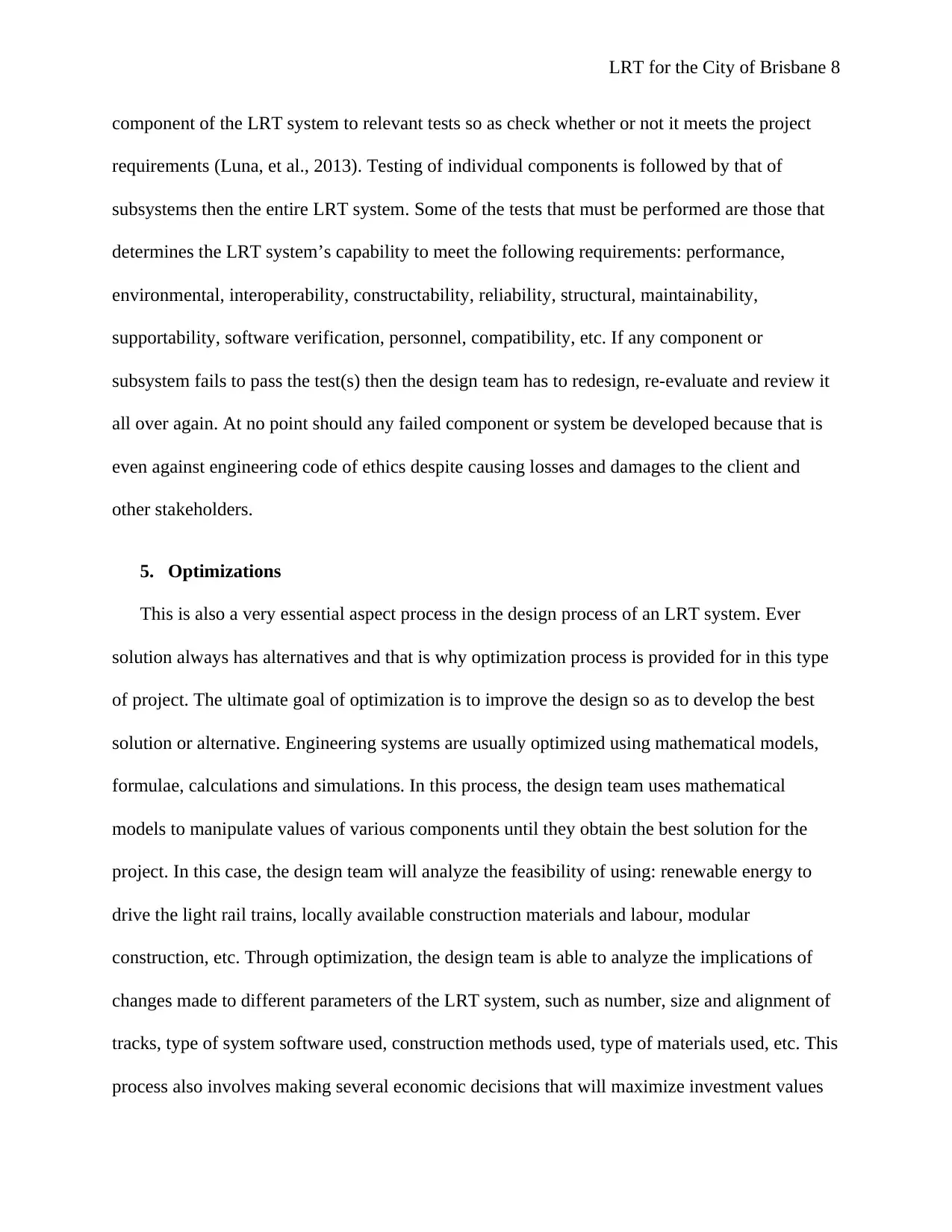
LRT for the City of Brisbane 8
component of the LRT system to relevant tests so as check whether or not it meets the project
requirements (Luna, et al., 2013). Testing of individual components is followed by that of
subsystems then the entire LRT system. Some of the tests that must be performed are those that
determines the LRT system’s capability to meet the following requirements: performance,
environmental, interoperability, constructability, reliability, structural, maintainability,
supportability, software verification, personnel, compatibility, etc. If any component or
subsystem fails to pass the test(s) then the design team has to redesign, re-evaluate and review it
all over again. At no point should any failed component or system be developed because that is
even against engineering code of ethics despite causing losses and damages to the client and
other stakeholders.
5. Optimizations
This is also a very essential aspect process in the design process of an LRT system. Ever
solution always has alternatives and that is why optimization process is provided for in this type
of project. The ultimate goal of optimization is to improve the design so as to develop the best
solution or alternative. Engineering systems are usually optimized using mathematical models,
formulae, calculations and simulations. In this process, the design team uses mathematical
models to manipulate values of various components until they obtain the best solution for the
project. In this case, the design team will analyze the feasibility of using: renewable energy to
drive the light rail trains, locally available construction materials and labour, modular
construction, etc. Through optimization, the design team is able to analyze the implications of
changes made to different parameters of the LRT system, such as number, size and alignment of
tracks, type of system software used, construction methods used, type of materials used, etc. This
process also involves making several economic decisions that will maximize investment values
component of the LRT system to relevant tests so as check whether or not it meets the project
requirements (Luna, et al., 2013). Testing of individual components is followed by that of
subsystems then the entire LRT system. Some of the tests that must be performed are those that
determines the LRT system’s capability to meet the following requirements: performance,
environmental, interoperability, constructability, reliability, structural, maintainability,
supportability, software verification, personnel, compatibility, etc. If any component or
subsystem fails to pass the test(s) then the design team has to redesign, re-evaluate and review it
all over again. At no point should any failed component or system be developed because that is
even against engineering code of ethics despite causing losses and damages to the client and
other stakeholders.
5. Optimizations
This is also a very essential aspect process in the design process of an LRT system. Ever
solution always has alternatives and that is why optimization process is provided for in this type
of project. The ultimate goal of optimization is to improve the design so as to develop the best
solution or alternative. Engineering systems are usually optimized using mathematical models,
formulae, calculations and simulations. In this process, the design team uses mathematical
models to manipulate values of various components until they obtain the best solution for the
project. In this case, the design team will analyze the feasibility of using: renewable energy to
drive the light rail trains, locally available construction materials and labour, modular
construction, etc. Through optimization, the design team is able to analyze the implications of
changes made to different parameters of the LRT system, such as number, size and alignment of
tracks, type of system software used, construction methods used, type of materials used, etc. This
process also involves making several economic decisions that will maximize investment values
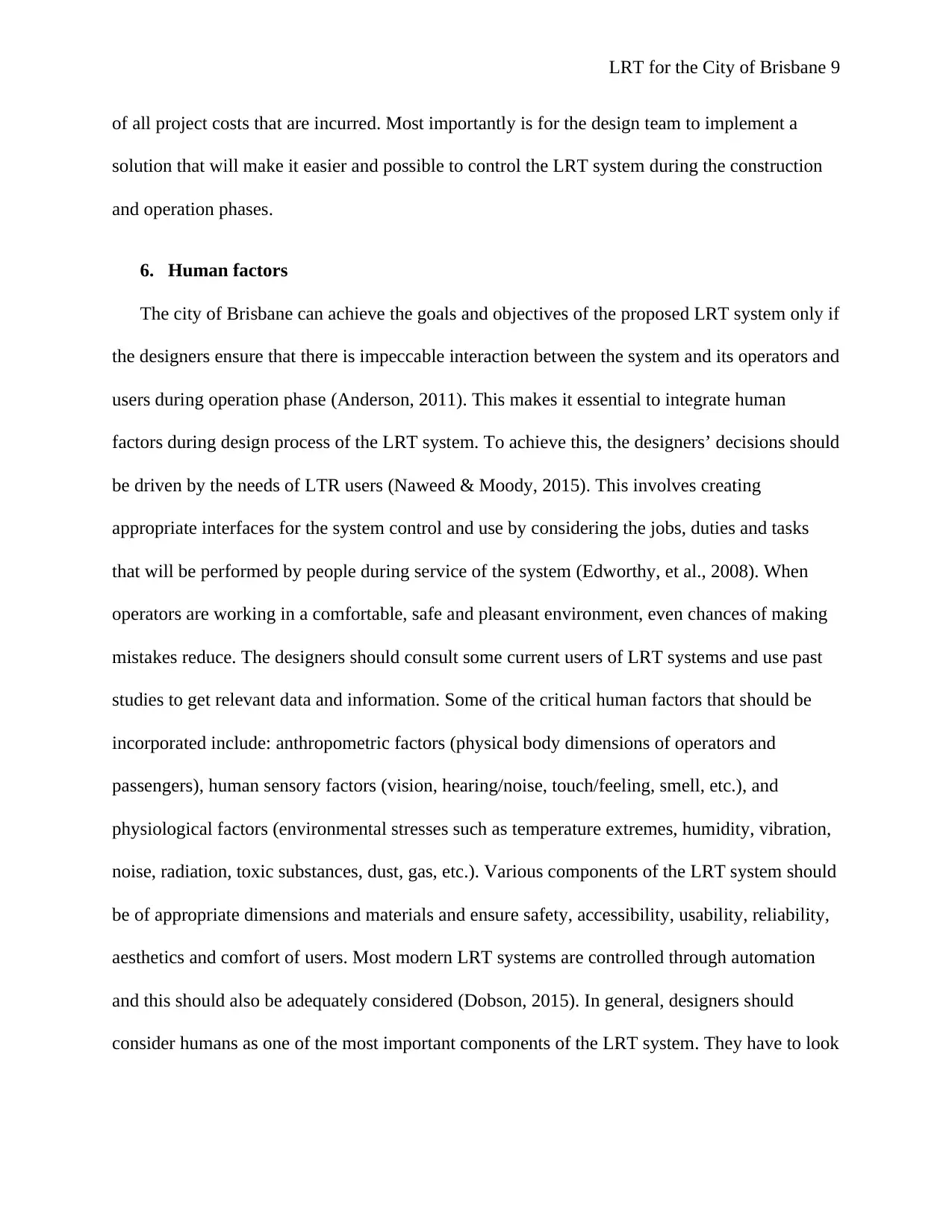
LRT for the City of Brisbane 9
of all project costs that are incurred. Most importantly is for the design team to implement a
solution that will make it easier and possible to control the LRT system during the construction
and operation phases.
6. Human factors
The city of Brisbane can achieve the goals and objectives of the proposed LRT system only if
the designers ensure that there is impeccable interaction between the system and its operators and
users during operation phase (Anderson, 2011). This makes it essential to integrate human
factors during design process of the LRT system. To achieve this, the designers’ decisions should
be driven by the needs of LTR users (Naweed & Moody, 2015). This involves creating
appropriate interfaces for the system control and use by considering the jobs, duties and tasks
that will be performed by people during service of the system (Edworthy, et al., 2008). When
operators are working in a comfortable, safe and pleasant environment, even chances of making
mistakes reduce. The designers should consult some current users of LRT systems and use past
studies to get relevant data and information. Some of the critical human factors that should be
incorporated include: anthropometric factors (physical body dimensions of operators and
passengers), human sensory factors (vision, hearing/noise, touch/feeling, smell, etc.), and
physiological factors (environmental stresses such as temperature extremes, humidity, vibration,
noise, radiation, toxic substances, dust, gas, etc.). Various components of the LRT system should
be of appropriate dimensions and materials and ensure safety, accessibility, usability, reliability,
aesthetics and comfort of users. Most modern LRT systems are controlled through automation
and this should also be adequately considered (Dobson, 2015). In general, designers should
consider humans as one of the most important components of the LRT system. They have to look
of all project costs that are incurred. Most importantly is for the design team to implement a
solution that will make it easier and possible to control the LRT system during the construction
and operation phases.
6. Human factors
The city of Brisbane can achieve the goals and objectives of the proposed LRT system only if
the designers ensure that there is impeccable interaction between the system and its operators and
users during operation phase (Anderson, 2011). This makes it essential to integrate human
factors during design process of the LRT system. To achieve this, the designers’ decisions should
be driven by the needs of LTR users (Naweed & Moody, 2015). This involves creating
appropriate interfaces for the system control and use by considering the jobs, duties and tasks
that will be performed by people during service of the system (Edworthy, et al., 2008). When
operators are working in a comfortable, safe and pleasant environment, even chances of making
mistakes reduce. The designers should consult some current users of LRT systems and use past
studies to get relevant data and information. Some of the critical human factors that should be
incorporated include: anthropometric factors (physical body dimensions of operators and
passengers), human sensory factors (vision, hearing/noise, touch/feeling, smell, etc.), and
physiological factors (environmental stresses such as temperature extremes, humidity, vibration,
noise, radiation, toxic substances, dust, gas, etc.). Various components of the LRT system should
be of appropriate dimensions and materials and ensure safety, accessibility, usability, reliability,
aesthetics and comfort of users. Most modern LRT systems are controlled through automation
and this should also be adequately considered (Dobson, 2015). In general, designers should
consider humans as one of the most important components of the LRT system. They have to look
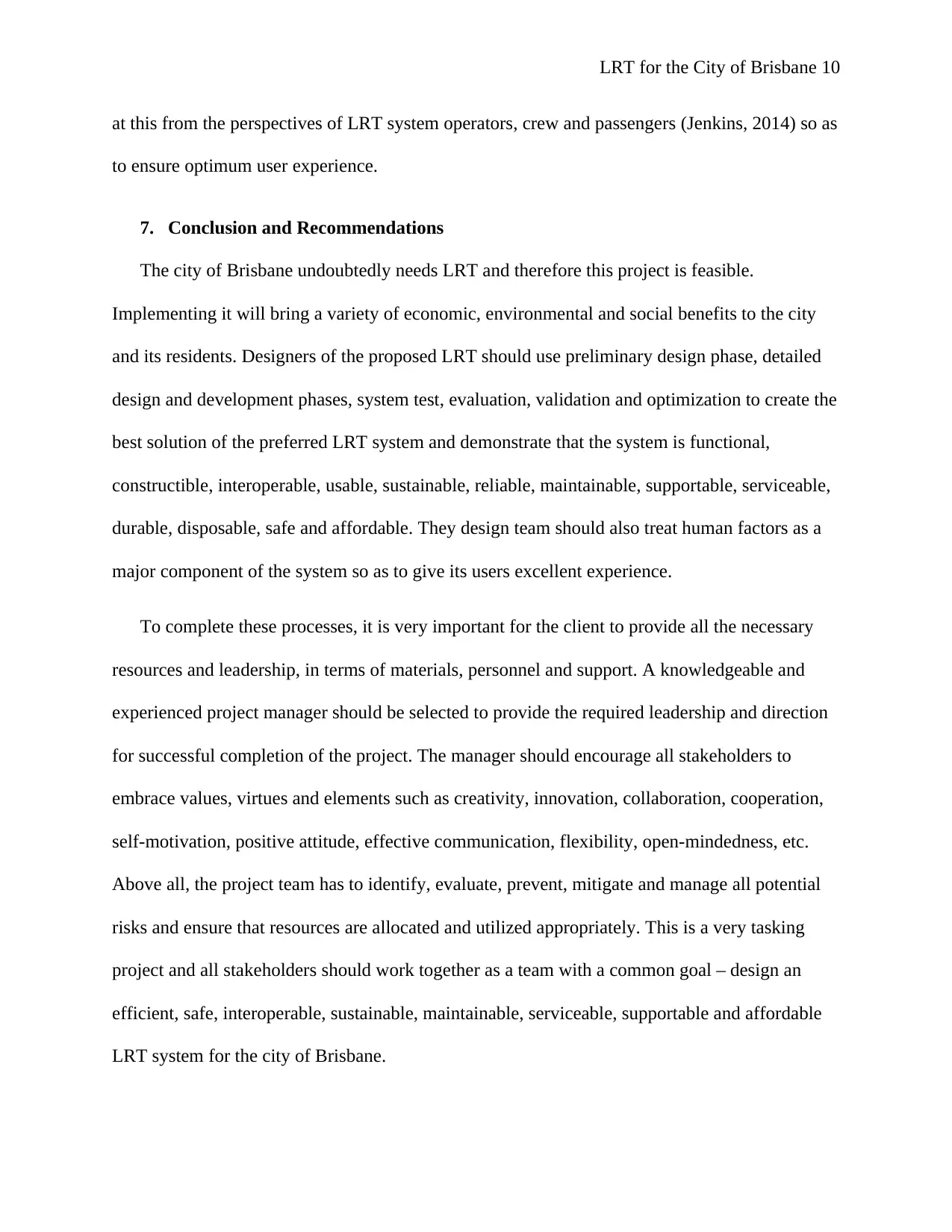
LRT for the City of Brisbane 10
at this from the perspectives of LRT system operators, crew and passengers (Jenkins, 2014) so as
to ensure optimum user experience.
7. Conclusion and Recommendations
The city of Brisbane undoubtedly needs LRT and therefore this project is feasible.
Implementing it will bring a variety of economic, environmental and social benefits to the city
and its residents. Designers of the proposed LRT should use preliminary design phase, detailed
design and development phases, system test, evaluation, validation and optimization to create the
best solution of the preferred LRT system and demonstrate that the system is functional,
constructible, interoperable, usable, sustainable, reliable, maintainable, supportable, serviceable,
durable, disposable, safe and affordable. They design team should also treat human factors as a
major component of the system so as to give its users excellent experience.
To complete these processes, it is very important for the client to provide all the necessary
resources and leadership, in terms of materials, personnel and support. A knowledgeable and
experienced project manager should be selected to provide the required leadership and direction
for successful completion of the project. The manager should encourage all stakeholders to
embrace values, virtues and elements such as creativity, innovation, collaboration, cooperation,
self-motivation, positive attitude, effective communication, flexibility, open-mindedness, etc.
Above all, the project team has to identify, evaluate, prevent, mitigate and manage all potential
risks and ensure that resources are allocated and utilized appropriately. This is a very tasking
project and all stakeholders should work together as a team with a common goal – design an
efficient, safe, interoperable, sustainable, maintainable, serviceable, supportable and affordable
LRT system for the city of Brisbane.
at this from the perspectives of LRT system operators, crew and passengers (Jenkins, 2014) so as
to ensure optimum user experience.
7. Conclusion and Recommendations
The city of Brisbane undoubtedly needs LRT and therefore this project is feasible.
Implementing it will bring a variety of economic, environmental and social benefits to the city
and its residents. Designers of the proposed LRT should use preliminary design phase, detailed
design and development phases, system test, evaluation, validation and optimization to create the
best solution of the preferred LRT system and demonstrate that the system is functional,
constructible, interoperable, usable, sustainable, reliable, maintainable, supportable, serviceable,
durable, disposable, safe and affordable. They design team should also treat human factors as a
major component of the system so as to give its users excellent experience.
To complete these processes, it is very important for the client to provide all the necessary
resources and leadership, in terms of materials, personnel and support. A knowledgeable and
experienced project manager should be selected to provide the required leadership and direction
for successful completion of the project. The manager should encourage all stakeholders to
embrace values, virtues and elements such as creativity, innovation, collaboration, cooperation,
self-motivation, positive attitude, effective communication, flexibility, open-mindedness, etc.
Above all, the project team has to identify, evaluate, prevent, mitigate and manage all potential
risks and ensure that resources are allocated and utilized appropriately. This is a very tasking
project and all stakeholders should work together as a team with a common goal – design an
efficient, safe, interoperable, sustainable, maintainable, serviceable, supportable and affordable
LRT system for the city of Brisbane.
Secure Best Marks with AI Grader
Need help grading? Try our AI Grader for instant feedback on your assignments.
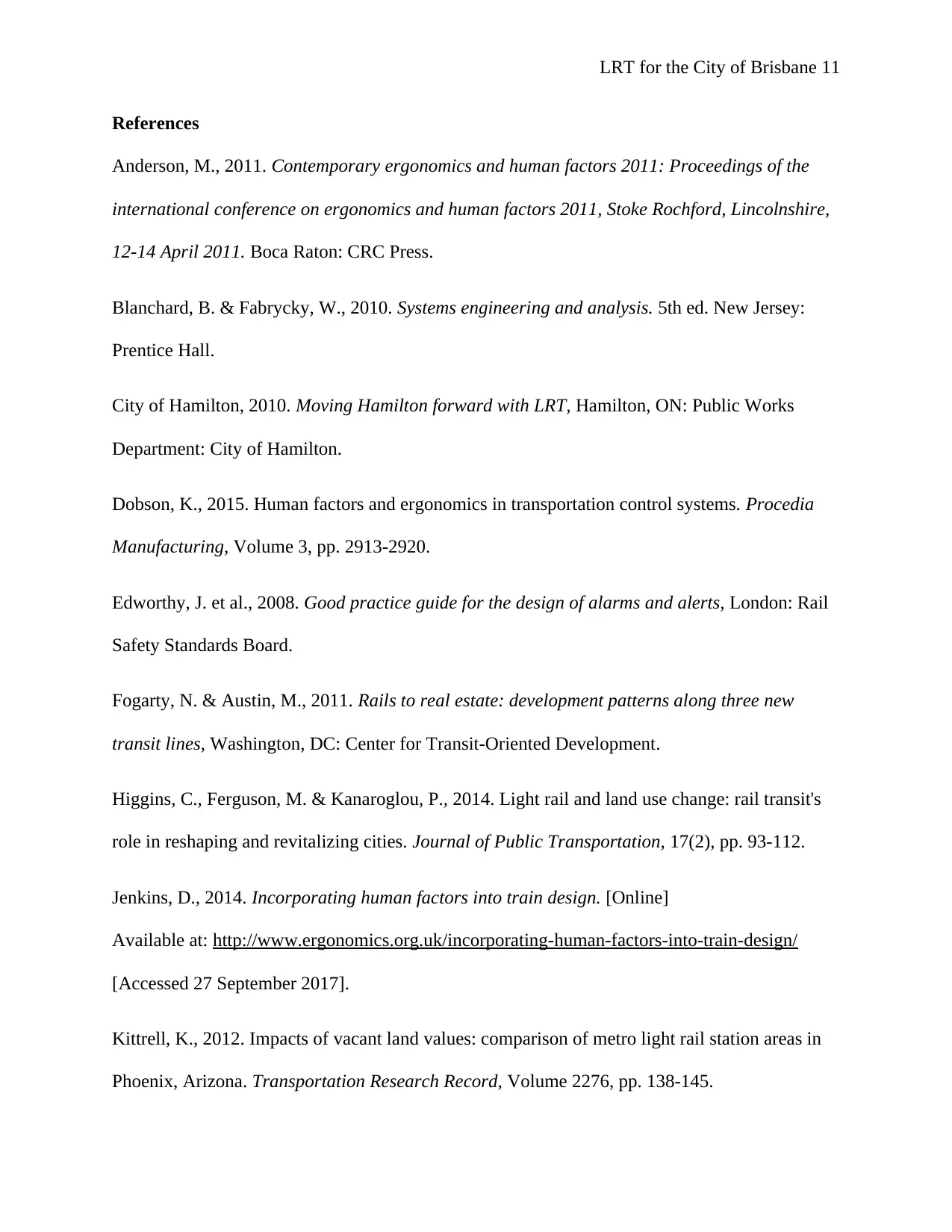
LRT for the City of Brisbane 11
References
Anderson, M., 2011. Contemporary ergonomics and human factors 2011: Proceedings of the
international conference on ergonomics and human factors 2011, Stoke Rochford, Lincolnshire,
12-14 April 2011. Boca Raton: CRC Press.
Blanchard, B. & Fabrycky, W., 2010. Systems engineering and analysis. 5th ed. New Jersey:
Prentice Hall.
City of Hamilton, 2010. Moving Hamilton forward with LRT, Hamilton, ON: Public Works
Department: City of Hamilton.
Dobson, K., 2015. Human factors and ergonomics in transportation control systems. Procedia
Manufacturing, Volume 3, pp. 2913-2920.
Edworthy, J. et al., 2008. Good practice guide for the design of alarms and alerts, London: Rail
Safety Standards Board.
Fogarty, N. & Austin, M., 2011. Rails to real estate: development patterns along three new
transit lines, Washington, DC: Center for Transit-Oriented Development.
Higgins, C., Ferguson, M. & Kanaroglou, P., 2014. Light rail and land use change: rail transit's
role in reshaping and revitalizing cities. Journal of Public Transportation, 17(2), pp. 93-112.
Jenkins, D., 2014. Incorporating human factors into train design. [Online]
Available at: http://www.ergonomics.org.uk/incorporating-human-factors-into-train-design/
[Accessed 27 September 2017].
Kittrell, K., 2012. Impacts of vacant land values: comparison of metro light rail station areas in
Phoenix, Arizona. Transportation Research Record, Volume 2276, pp. 138-145.
References
Anderson, M., 2011. Contemporary ergonomics and human factors 2011: Proceedings of the
international conference on ergonomics and human factors 2011, Stoke Rochford, Lincolnshire,
12-14 April 2011. Boca Raton: CRC Press.
Blanchard, B. & Fabrycky, W., 2010. Systems engineering and analysis. 5th ed. New Jersey:
Prentice Hall.
City of Hamilton, 2010. Moving Hamilton forward with LRT, Hamilton, ON: Public Works
Department: City of Hamilton.
Dobson, K., 2015. Human factors and ergonomics in transportation control systems. Procedia
Manufacturing, Volume 3, pp. 2913-2920.
Edworthy, J. et al., 2008. Good practice guide for the design of alarms and alerts, London: Rail
Safety Standards Board.
Fogarty, N. & Austin, M., 2011. Rails to real estate: development patterns along three new
transit lines, Washington, DC: Center for Transit-Oriented Development.
Higgins, C., Ferguson, M. & Kanaroglou, P., 2014. Light rail and land use change: rail transit's
role in reshaping and revitalizing cities. Journal of Public Transportation, 17(2), pp. 93-112.
Jenkins, D., 2014. Incorporating human factors into train design. [Online]
Available at: http://www.ergonomics.org.uk/incorporating-human-factors-into-train-design/
[Accessed 27 September 2017].
Kittrell, K., 2012. Impacts of vacant land values: comparison of metro light rail station areas in
Phoenix, Arizona. Transportation Research Record, Volume 2276, pp. 138-145.
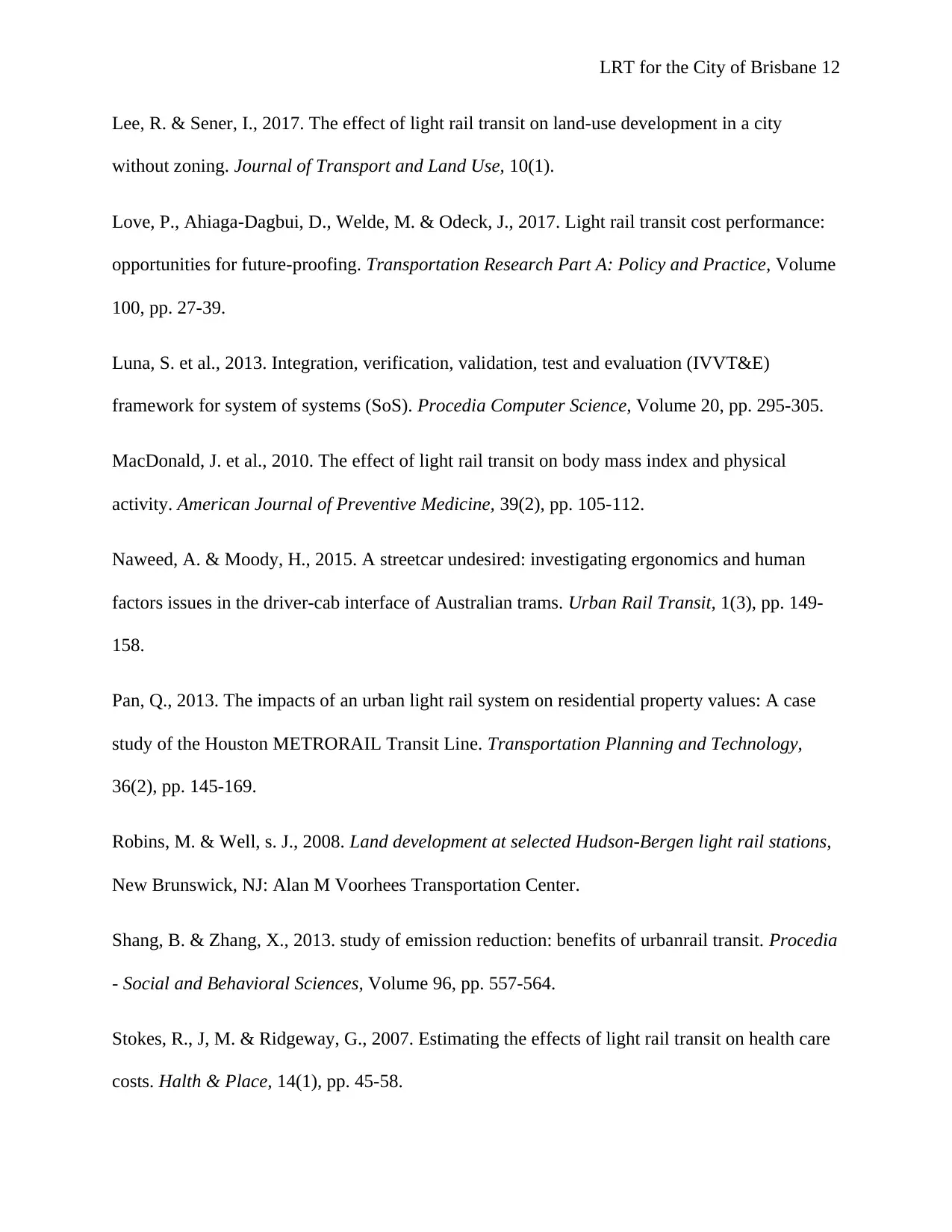
LRT for the City of Brisbane 12
Lee, R. & Sener, I., 2017. The effect of light rail transit on land-use development in a city
without zoning. Journal of Transport and Land Use, 10(1).
Love, P., Ahiaga-Dagbui, D., Welde, M. & Odeck, J., 2017. Light rail transit cost performance:
opportunities for future-proofing. Transportation Research Part A: Policy and Practice, Volume
100, pp. 27-39.
Luna, S. et al., 2013. Integration, verification, validation, test and evaluation (IVVT&E)
framework for system of systems (SoS). Procedia Computer Science, Volume 20, pp. 295-305.
MacDonald, J. et al., 2010. The effect of light rail transit on body mass index and physical
activity. American Journal of Preventive Medicine, 39(2), pp. 105-112.
Naweed, A. & Moody, H., 2015. A streetcar undesired: investigating ergonomics and human
factors issues in the driver-cab interface of Australian trams. Urban Rail Transit, 1(3), pp. 149-
158.
Pan, Q., 2013. The impacts of an urban light rail system on residential property values: A case
study of the Houston METRORAIL Transit Line. Transportation Planning and Technology,
36(2), pp. 145-169.
Robins, M. & Well, s. J., 2008. Land development at selected Hudson-Bergen light rail stations,
New Brunswick, NJ: Alan M Voorhees Transportation Center.
Shang, B. & Zhang, X., 2013. study of emission reduction: benefits of urbanrail transit. Procedia
- Social and Behavioral Sciences, Volume 96, pp. 557-564.
Stokes, R., J, M. & Ridgeway, G., 2007. Estimating the effects of light rail transit on health care
costs. Halth & Place, 14(1), pp. 45-58.
Lee, R. & Sener, I., 2017. The effect of light rail transit on land-use development in a city
without zoning. Journal of Transport and Land Use, 10(1).
Love, P., Ahiaga-Dagbui, D., Welde, M. & Odeck, J., 2017. Light rail transit cost performance:
opportunities for future-proofing. Transportation Research Part A: Policy and Practice, Volume
100, pp. 27-39.
Luna, S. et al., 2013. Integration, verification, validation, test and evaluation (IVVT&E)
framework for system of systems (SoS). Procedia Computer Science, Volume 20, pp. 295-305.
MacDonald, J. et al., 2010. The effect of light rail transit on body mass index and physical
activity. American Journal of Preventive Medicine, 39(2), pp. 105-112.
Naweed, A. & Moody, H., 2015. A streetcar undesired: investigating ergonomics and human
factors issues in the driver-cab interface of Australian trams. Urban Rail Transit, 1(3), pp. 149-
158.
Pan, Q., 2013. The impacts of an urban light rail system on residential property values: A case
study of the Houston METRORAIL Transit Line. Transportation Planning and Technology,
36(2), pp. 145-169.
Robins, M. & Well, s. J., 2008. Land development at selected Hudson-Bergen light rail stations,
New Brunswick, NJ: Alan M Voorhees Transportation Center.
Shang, B. & Zhang, X., 2013. study of emission reduction: benefits of urbanrail transit. Procedia
- Social and Behavioral Sciences, Volume 96, pp. 557-564.
Stokes, R., J, M. & Ridgeway, G., 2007. Estimating the effects of light rail transit on health care
costs. Halth & Place, 14(1), pp. 45-58.

LRT for the City of Brisbane 13
Xia, H. et al., 2017. Challenges in the integration of light rail and land use: A case study of
Yizhuang Line in Beijing. Urban Rail Transit, 3(1), pp. 45-53.
Xia, H. et al., 2017. Challenges in the integration of light rail and land use: A case study of
Yizhuang Line in Beijing. Urban Rail Transit, 3(1), pp. 45-53.
1 out of 13
Related Documents
Your All-in-One AI-Powered Toolkit for Academic Success.
+13062052269
info@desklib.com
Available 24*7 on WhatsApp / Email
![[object Object]](/_next/static/media/star-bottom.7253800d.svg)
Unlock your academic potential
© 2024 | Zucol Services PVT LTD | All rights reserved.





